Connections is a daily puzzle game published by The New York Times Games. Each puzzle presents 16 words. Your task: split them into four groups of four, where each group shares a hidden theme (for instance, items in a category, a prefix/suffix, word-play relationships, etc.).
When you submit a correct group, the game reveals the category and colors it based on difficulty (yellow = easiest, green, blue, and purple = hardest).
A connections hint is a subtle clue—either provided by a hint source or a solver—that nudges you toward recognizing one of the hidden themes or associative patterns. Hints are helpful when you’re stuck or when one group is stubborn and not obvious.
Because each daily puzzle has exactly one correct solution, hints must be handled carefully: too obvious, and the challenge disappears; too vague, and they don’t help.
🗓️ Example: Connections Hint for October 5
To show how a Connections hint looks in practice, let’s consider the puzzle on October 5, 2025 (game #847).
Words & Groups (for reference)
Here are the four thematic groups from that day: Word Tips
- GROW / PLANT theme
- POT, SEED, SOIL, WATER
- SHOCK / surprise / jolt theme
- FLOOR, ROCK, SHAKE, SHOCK
- Madonna song titles
- CHERISH, FROZEN, HOLIDAY, MUSIC
- “___ car” phrases
- BUMPER, CLOWN, GETAWAY, SPORTS
If you didn’t see the solution yet, here are hints (without full spoilering):
- For the Madonna songs group: think of song titles by that pop icon.
- For the ____ car theme: all words can precede or follow car (e.g., bumper car, sports car).
- For the grow / plant cluster: the four are essential elements in gardening or planting.
- For shock / tremor group: these words tie to “shake” or “shock” types (e.g. rock, floor, shake, shock).
Using one or two of these hints may help you find the harder groups without giving away everything.
🧠 Strategies for Using Connections Hints Well
Hints are most useful when they help you break open a stubborn group rather than complete the entire puzzle. Here are some strategies:
1. Start with the easiest group
Yellow-level categories tend to be the most straightforward. Once you identify that, those four words are removed, narrowing the search space.
2. Avoid overcommitting to one link
Sometimes a word seems to fit more than one possible category. Use hints to test if the intended grouping is stronger. Reddit users often caution about “words that seem to belong to multiple categories.”
3. Work in reverse
If three groups are obvious (with or without hints), the last group is often the “default” by elimination.
4. Use partial hints
If a hint reveals only one word or one association in a group (rather than revealing the full category name), it’s often safer—they guide without spoiling.
5. Time your hints
Sometimes delaying use of a hint helps you find the theme yourself. If you’re stuck too long, a well-timed nudge can prevent frustration.
🔬 Why Hints and Connections Are Interesting — Even to Researchers
Beyond being a fun puzzle, Connections has become a subject of study in AI, cognition, and language. Researchers test how well machines and humans can form abstract conceptual groupings.
One study found that even powerful AI models like GPT-4 lag behind expert humans in solving these puzzles, especially when hints or nuanced wordplay are required.
Also, from a combinatorial viewpoint, the number of possible ways to group 16 words into 4 groups of 4 is enormous (tens of millions). Algorithms often rely on measuring semantic coherence or vector similarity to guess groupings.
So a good hint can act as a “shortcut,” emulating the kind of human insight that AI struggles to replicate.
✅ Best Practices to Improve at Using Connections Hints
- Keep a record of past puzzles and how hints led you to themes
- Learn common thematic patterns (colors, parts of speech, categories)
- Don’t rush to submit groups; test them in your mind first
- Use hints sparingly — primarily for purple/difficult groups
- Discuss with other solvers (forums, social media) for lateral thinking
🏁 Conclusion
A Connections hint is not just a pointer — it’s a mini-reveal that bridges the gap between what you see and what’s hidden. Used well, hints transform a puzzle from frustrating to enlightening. Whether you’re tackling Connections hint today, Connections hint October 5, or a future puzzle, thoughtful hints sharpen pattern recognition and deepen your enjoyment.
❓ Frequently Asked Questions (FAQs)
1. What exactly is a “Connections hint”?
A hint is a partial clue suggesting a theme or relation among a subset of the 16 words, without giving away the entire category.
2. How many hints are allowed?
The original NYT Connections game doesn’t officially give hints; hint sites or guides provide them. In gameplay, you’re allowed up to four mistakes before the puzzle reveals the answers.
3. Does using a hint mean I’ve spoiled the puzzle?
Not necessarily—good hints guide you without full spoilers. Many hint providers delay full answers so you can try solving first.
4. Why are some groups harder (purple) and need hints more often?
Purple groups often rely on subtle wordplay, multiword phrases, or obscure associations. They’re designed to test deeper connections.
5. Can I use hints every day?
Yes, many websites publish daily Connections hints (e.g. yellow/green/blue/purple hints). But using them too early may reduce your puzzle-solving satisfaction.
